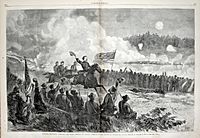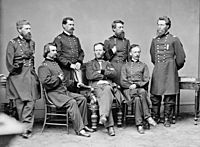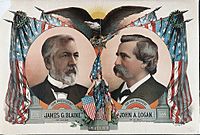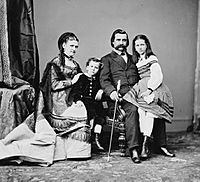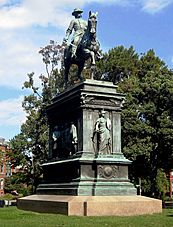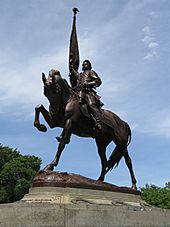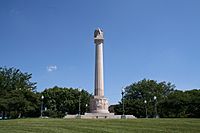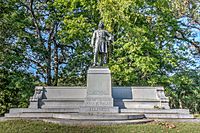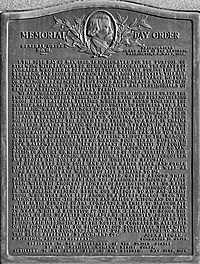John A. Logan facts for kids
Quick facts for kids
John Logan
|
|
|---|---|
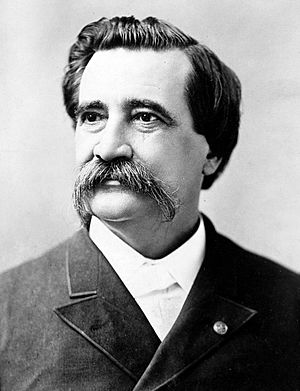 |
|
| United States Senator from Illinois |
|
| In office March 4, 1879 – December 26, 1886 |
|
| Preceded by | Richard Oglesby |
| Succeeded by | Charles B. Farwell |
| In office March 4, 1871 – March 3, 1877 |
|
| Preceded by | Richard Yates |
| Succeeded by | David Davis |
| Member of the U.S. House of Representatives from Illinois's at-large district |
|
| In office March 4, 1867 – March 3, 1871 |
|
| Preceded by | Samuel W. Moulton |
| Succeeded by | John Lourie Beveridge |
| Member of the U.S. House of Representatives from Illinois's 9th district |
|
| In office March 4, 1859 – April 2, 1862 |
|
| Preceded by | Samuel S. Marshall |
| Succeeded by | William Allen |
| Personal details | |
| Born |
John Alexander Logan
February 9, 1826 Murphysboro, Illinois, U.S. |
| Died | December 26, 1886 (aged 60) Washington, D.C., U.S. |
| Political party | Democratic (before 1866) Republican (1866–1886) |
| Education | Shiloh College University of Louisville (LLB) |
| Signature | |
| Nickname | "Black Jack" |
| Military service | |
| Allegiance | |
| Branch/service | Union Army |
| Years of service | 1847–1848 (U.S. Army) 1861–1865 (Union Army) |
| Rank | |
| Commands | XV Corps |
| Battles/wars | Mexican-American War American Civil War • First Battle of Bull Run • Battle of Belmont • Battle of Fort Donelson • Second Battle of Corinth • Vicksburg Campaign • Battle of Atlanta • Battle of Jonesborough • Battle of Bentonville |
John Alexander Logan (February 9, 1826 – December 26, 1886) was an important American soldier and politician. He fought in the Mexican–American War and became a general in the Union Army during the American Civil War. Logan represented Illinois in many roles. He was a State Senator, a Congressman, and a U.S. Senator.
In 1884, he ran for Vice President of the United States but did not win. Logan is most famous for helping to create Memorial Day. This holiday honors soldiers who died serving their country. He was the 3rd Commander-in-Chief of the Grand Army of the Republic, a group for Civil War veterans.
You can find statues of John A. Logan in Washington, D.C. and Grant Park in Chicago. Several places are named after him, like counties in Kansas, Oklahoma, Colorado, and North Dakota. He is also mentioned in the Illinois state song.
Contents
Becoming a Leader: Early Life and Politics
John A. Logan was born near Murphysboro, Illinois, in 1826. His father was Dr. John Logan. John A. Logan studied with his father and a tutor. He also spent three years at Shiloh College.
He joined the 1st Illinois Infantry during the Mexican–American War. He became a second lieutenant. After the war, Logan studied law and became a successful lawyer.
Logan started his political career as a Democrat. He was elected county clerk in 1849. He served in the Illinois House of Representatives from 1853 to 1854 and again in 1857. He also worked as a prosecuting attorney. In 1858 and 1860, he was elected to the United States House of Representatives. In 1853, John A. Logan supported a law that made it difficult for African Americans, including those who were free, to settle in Illinois. This was a common but unfair practice at the time.
Serving the Nation: The Civil War
Even while he was a U.S. Representative, Logan fought as a volunteer at the First Battle of Bull Run. He then returned to Washington. On April 2, 1862, he left Congress to join the Union Army. He became a colonel of the 31st Illinois Volunteer Infantry Regiment, which he helped create.
His soldiers called him "Black Jack." This was because of his dark eyes, black hair, and tanned skin. Logan was known as one of the best officers who came from civilian life. Many politicians who became generals did not do well in battle, but Logan was different.
Logan served under General Ulysses S. Grant in the Western Theater. He was at the Battle of Belmont in November 1861, where his horse was shot. He was also wounded at Fort Donelson in February 1862. After the victory at Donelson, he was promoted to brigadier general.
During the Siege of Corinth, Logan led a brigade and then a division. In 1863, he was promoted to major general.
Key Battles and Commands
In Grant's Vicksburg Campaign, Logan led a division. His troops were the first to enter Vicksburg in July 1863 after the city was captured. Logan then became the military governor of Vicksburg.
Later, he took command of the XV Corps. At the Battle of Atlanta in July 1864, Logan took command of the Army of the Tennessee after General James B. McPherson died. He also led his XV Corps in General Sherman's Carolinas Campaign.
After the War: A Political Return
After the Civil War, Logan went back to politics. He became a Republican. He served in the United States House of Representatives from 1867 to 1871. Then he was a U.S. Senator from 1871 to 1877, and again from 1879 until he died in 1886.
Logan was known for his strong and passionate speeches. These speeches were popular with the public. In 1868, he was one of the managers in the effort to remove U.S. President Andrew Johnson from office.
Logan was the second Commander-in-Chief of the Grand Army of the Republic. This group was made up of Union Army veterans. From 1868 to 1871, he helped lead the effort to make Memorial Day a national holiday. Memorial Day was originally called Decoration Day.
His military record and his popularity among veterans helped him get nominated for Vice President of the United States in 1884. He ran with James G. Blaine, but they lost the election.
John A. Logan passed away on December 26, 1886, in Washington, D.C. His body was placed in the United States Capitol for people to pay their respects. He was buried at the United States Soldiers' and Airmen's Home National Cemetery in Washington.
Logan wrote two books about the Civil War. One was called The Great Conspiracy: Its Origin and History (1886). The other was The Volunteer Soldier of America (1887). His son, John Alexander Logan Jr., also became an army officer. He received the Medal of Honor after he died for his bravery.
Logan's Legacy: Honoring a Hero
The State of Illinois has an equestrian statue of General Logan in Chicago's Grant Park. Another equestrian statue stands in Logan Circle in Washington, D.C.. This circle gives its name to the area around it.
Many places are named after John A. Logan. These include Logan Square, Chicago and Logan Boulevard in Chicago. Also, Logan Avenue and the neighborhood of Logan Heights in San Diego. His hometown, Murphysboro, Illinois, has the General John A Logan Museum. There is also the General John A. Logan Elementary School. In nearby Carterville, Illinois, you can find John A. Logan College, which is a community college.
Logan is one of only three people mentioned by name in the Illinois state song:
On the record of thy years,
Abraham Lincoln's name appears,
Grant and Logan, and our tears,
Illinois, Illinois,
Grant and Logan, and our tears,
Illinois.
- Logan County, Kansas was named after General Logan.
- Logan County, Oklahoma, is named in his honor.
- Logan County, Colorado, is named in his honor.
- Logan County, North Dakota, is named in his honor.
- Logan Junior High School in Princeton, Illinois is named after him.
- The Logan House in Wilmington, Delaware is an old Irish Pub named in his honor.
- Logan's final resting place is a large stone building at the U.S. Soldiers' and Airmen's Home National Cemetery. It holds the remains of General John A. Logan and his family.
Images for kids


